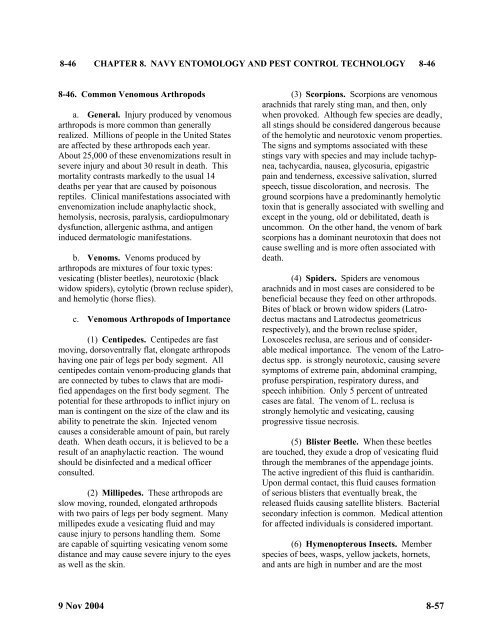NAVMED P-5010-8 - Navy Medicine - U.S. Navy
NAVMED P-5010-8 - Navy Medicine - U.S. Navy
NAVMED P-5010-8 - Navy Medicine - U.S. Navy
You also want an ePaper? Increase the reach of your titles
YUMPU automatically turns print PDFs into web optimized ePapers that Google loves.
8-46 CHAPTER 8. NAVY ENTOMOLOGY AND PEST CONTROL TECHNOLOGY 8-46<br />
8-46. Common Venomous Arthropods<br />
a. General. Injury produced by venomous<br />
arthropods is more common than generally<br />
realized. Millions of people in the United States<br />
are affected by these arthropods each year.<br />
About 25,000 of these envenomizations result in<br />
severe injury and about 30 result in death. This<br />
mortality contrasts markedly to the usual 14<br />
deaths per year that are caused by poisonous<br />
reptiles. Clinical manifestations associated with<br />
envenomization include anaphylactic shock,<br />
hemolysis, necrosis, paralysis, cardiopulmonary<br />
dysfunction, allergenic asthma, and antigen<br />
induced dermatologic manifestations.<br />
b. Venoms. Venoms produced by<br />
arthropods are mixtures of four toxic types:<br />
vesicating (blister beetles), neurotoxic (black<br />
widow spiders), cytolytic (brown recluse spider),<br />
and hemolytic (horse flies).<br />
c. Venomous Arthropods of Importance<br />
(1) Centipedes. Centipedes are fast<br />
moving, dorsoventrally flat, elongate arthropods<br />
having one pair of legs per body segment. All<br />
centipedes contain venom-producing glands that<br />
are connected by tubes to claws that are modified<br />
appendages on the first body segment. The<br />
potential for these arthropods to inflict injury on<br />
man is contingent on the size of the claw and its<br />
ability to penetrate the skin. Injected venom<br />
causes a considerable amount of pain, but rarely<br />
death. When death occurs, it is believed to be a<br />
result of an anaphylactic reaction. The wound<br />
should be disinfected and a medical officer<br />
consulted.<br />
(2) Millipedes. These arthropods are<br />
slow moving, rounded, elongated arthropods<br />
with two pairs of legs per body segment. Many<br />
millipedes exude a vesicating fluid and may<br />
cause injury to persons handling them. Some<br />
are capable of squirting vesicating venom some<br />
distance and may cause severe injury to the eyes<br />
as well as the skin.<br />
(3) Scorpions. Scorpions are venomous<br />
arachnids that rarely sting man, and then, only<br />
when provoked. Although few species are deadly,<br />
all stings should be considered dangerous because<br />
of the hemolytic and neurotoxic venom properties.<br />
The signs and symptoms associated with these<br />
stings vary with species and may include tachypnea,<br />
tachycardia, nausea, glycosuria, epigastric<br />
pain and tenderness, excessive salivation, slurred<br />
speech, tissue discoloration, and necrosis. The<br />
ground scorpions have a predominantly hemolytic<br />
toxin that is generally associated with swelling and<br />
except in the young, old or debilitated, death is<br />
uncommon. On the other hand, the venom of bark<br />
scorpions has a dominant neurotoxin that does not<br />
cause swelling and is more often associated with<br />
death.<br />
(4) Spiders. Spiders are venomous<br />
arachnids and in most cases are considered to be<br />
beneficial because they feed on other arthropods.<br />
Bites of black or brown widow spiders (Latrodectus<br />
mactans and Latrodectus geometricus<br />
respectively), and the brown recluse spider,<br />
Loxosceles reclusa, are serious and of considerable<br />
medical importance. The venom of the Latrodectus<br />
spp. is strongly neurotoxic, causing severe<br />
symptoms of extreme pain, abdominal cramping,<br />
profuse perspiration, respiratory duress, and<br />
speech inhibition. Only 5 percent of untreated<br />
cases are fatal. The venom of L. reclusa is<br />
strongly hemolytic and vesicating, causing<br />
progressive tissue necrosis.<br />
(5) Blister Beetle. When these beetles<br />
are touched, they exude a drop of vesicating fluid<br />
through the membranes of the appendage joints.<br />
The active ingredient of this fluid is cantharidin.<br />
Upon dermal contact, this fluid causes formation<br />
of serious blisters that eventually break, the<br />
released fluids causing satellite blisters. Bacterial<br />
secondary infection is common. Medical attention<br />
for affected individuals is considered important.<br />
(6) Hymenopterous Insects. Member<br />
species of bees, wasps, yellow jackets, hornets,<br />
and ants are high in number and are the most<br />
9 Nov 2004<br />
8-57
















